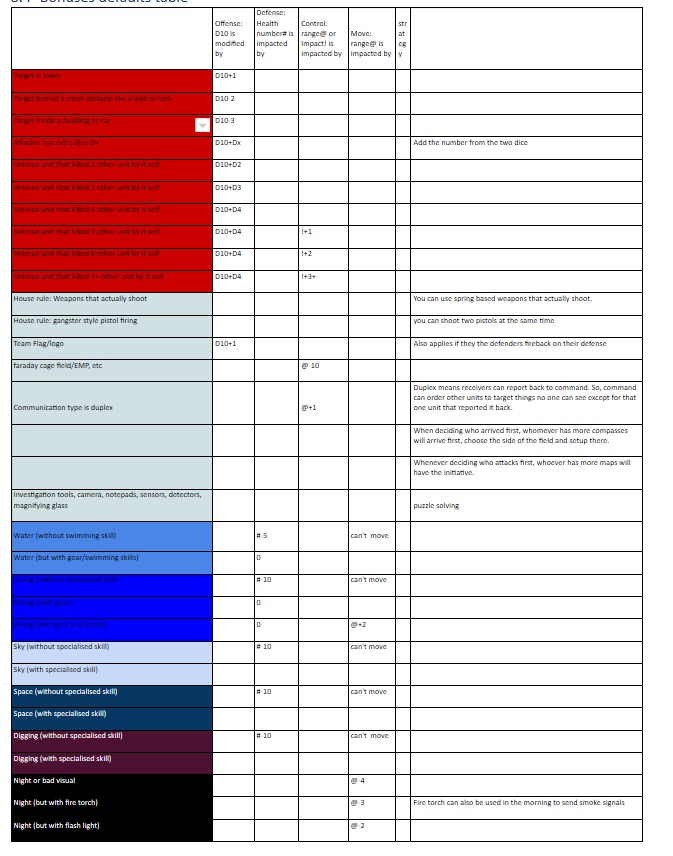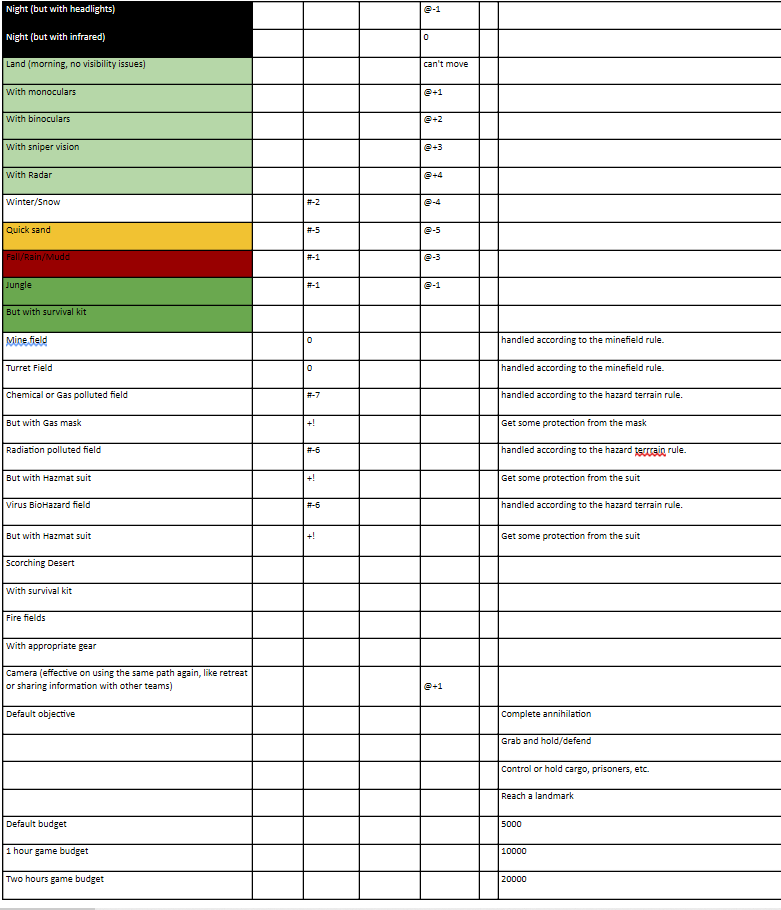-

8- Justification of some design decisions
There are a couple of ideas that govern how the rules are developed. On one side we want the game to be as detailed and simulating real and fantasy universes as much as possible, but on the other side we do not want it to be boring. We want to put emphasis on deterministic mathematical operations without losing the randomness and excitement that is brought in by the dice. And above all we want one open source equation to calculate everything so anyone can develop new skills and armies while keeping the game balance in check. While calibrating anything, we try to compare with the defense category, particularly the health points since they are the baseline for everything. They have a 100% probability, are discharged in an impact ! of 1, and they are the main objective for everyone. By objective, we mean that we want to kill the enemy units by removing all their health points. So whenever, we create new, or recalibrate old skill, we compare with health points and see if it makes sense.
8.1- Potential loopholes in the gaming system
8.1.1- Weapons explosion circumference
We’re always on the hunt for loopholes that can make the game imbalanced or too slow. For example we’ve had a loophole where the extension of offence * was interpreted as a radius. That turned out to be too much and we now interpret it as the circumference. The easiest way to approximate the diameter from the circumference is divided by 3
circumference = 2 r, so r =circumference / 2 , = 3.14 , so roughly diameter = circumference / 3
This, along with other factors, can lead to a small loophole where a player intentionally aligns the impact and the circumference of their weapons to always (or more often than not) land on the lower end of a fraction. And since the general rule of thumb is always round up and go for the kill this could add up to a significant advantage. Another intentional loophole is that it is much cheaper to invest in weapons than it is to do so in health and armor. This is intentional to make the game go faster. After all, it is a war game. (Fast-play)8.1.2- Pilot vs Robot
Why is it better to use a pilot or drive vehicles rather than AI robotics? Even though it is cheaper to exclude the human move, control, defense, and offense capabilities, it is not significant. Having a human or other creature driving / piloting the machine is not too bad since they can leave to do other missions and prevail after the destruction of the machine. Both can be hacked digitally or psychologically.
8.1.3- Why operate a vehicle with multiple units?
Large vehicles might have multiple persons manning the different guns and equipment on it. If they are set in a rank hierarchy they can fire multiple guns at the same time which would increase the fire power density of this vehicle.
8.1.4- Multiple vs one unit
Why is it better to use multiple units instead of just beefing up one unit with weapons and armor? One reason is that multiple units can shoot at the same time from multiple areas maximizing the pincer bonus and diversifying the attack. The command cost overhead and multiplication of the cost movement skills makes it very feasible to just use one unit. To counter that we use D10 x 22,32,42,52, or 62 depending on how many sides are in the pincer attack.
* Issue: one beefed up halo spartan unit is undefeatable. This is true unless the opposing team is another one unit team. It looks like consolidating the budget in one unit tilts the game towards the team with less units.
* Analysis: Create a mock up scenario with 2 teams having the same budget. One team is just one unit and the other is 10 units. From the table you can see that the diversified team is weak even without wasting money on control. The diversified team has to be distant enough not to be impacted by explosion but still be within the range of healing and communication. chain of command is a very vulnerable concept.
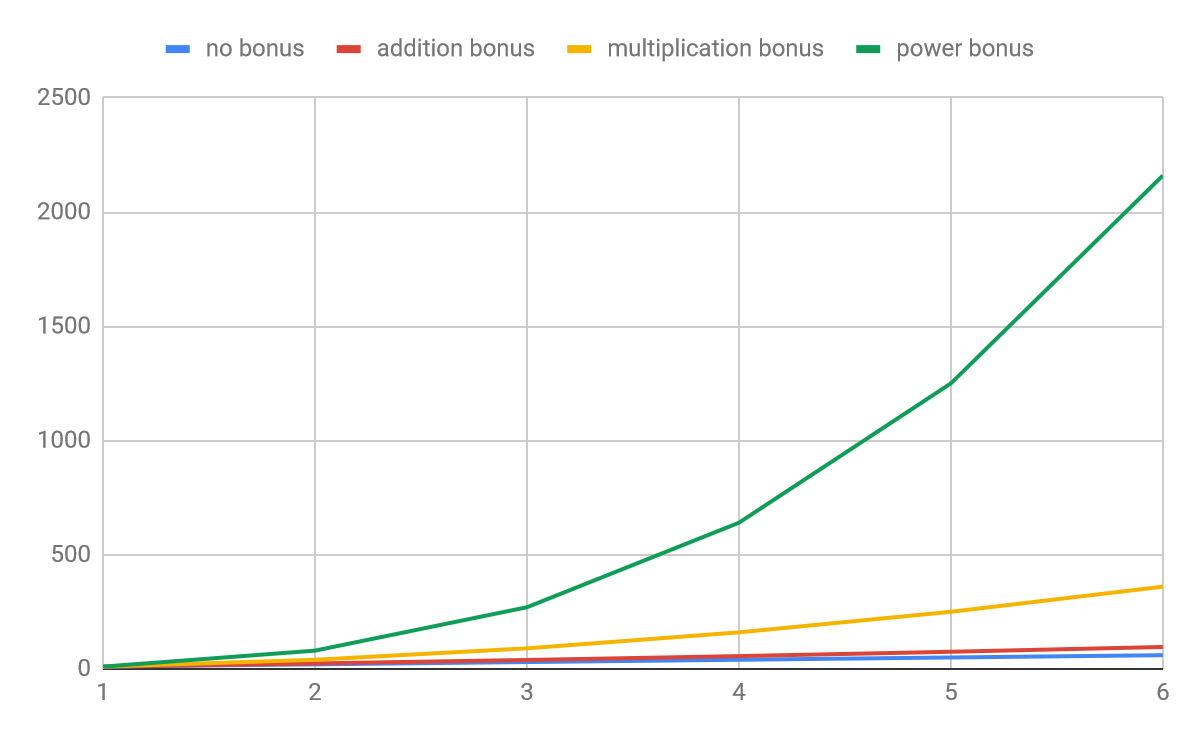
* Pro consolidation: Way more powerful (range and impact). With extension the damage is even better on diversified teams. Way faster. No control cost. if bosses die the individuals become very weak.
* Pro diversification: can do pincer moves, up to D10+6. better odds as you can roll more dice and choose the highest. Since there is one target unit, no offence impact units are lost except for the last offense before the target dies. can hold multiple critical locations and use multiple bonus dice. get multiple dice rounded up.
* Conclusion: Diversified units are much weaker. we need to amplify the effect of pincering to compensate for that. maybe, for every extra unit attacking you get D10+n for each.
* Solution: use D10 x 4,9,16,25, or 36 instead of D10 + 2,3,4,5, or 6. By doing this multiple units are a match for a single consolidated unit including the communication and extra movement overhead. The landscape has to be defined to avoid perpetual retreat.
8.1.5- Benefit of Movement Maneuver leverage
Movement Height and Depth (Maneuver leverage) is very expensive compared to investing in Armour. What is the benefit? The cause of inflated investment is that it gets multiplied by the default energy value. To fix this loophole everytime the higher unit attacks, the difference in leverage is added to the impact before the dice are rolled. For example, a chopper with an elevation of 15 inch attacking a walker with height of 10 with impact=10 and D10=7 will yield: (6+(15-10))x7/10 = 7.7 ~=8effective impact.
8.1.6- Benefits of having multiple weapons
Especially if you are not tracking how much ammunition was used, having multiple weapons would seem unnecessary. There are important reasons why a unit should have multiple weapons though. If a unit has a range weapon and it got too near to it’s opponent, within 10% of the range @ of it’s weapon, the dice roll takes a D10-5 penalty since it is harder to shoot a range weapon in close combat. This means that it is much better to have a melee weapon available to use in such cases. This is very important in case the unit has a weapon with an explosion circumference * as the unit itself will get hurt while firing. Another benefit is that it helps counter the opponent disarming your unit. If a unit is disarmed it can be very easily captured as a prisoner or just killed but if it has multiple weapons disarmament is much less likely.
8.1.7- Why can’t I use a D20 for attack
You can but you have to pay more for it. A weapon with impact !=1 and ammunition #=20 will roll the numbers between 1 (10%) and 10 (100%) twice each. That is on average of course. This makes the efficiency of this weapon 11 actual impact ! out of the 20 charges. Average usable impact=10/2x(.1+1)=5.5. Multiply this by 2 because each will happen twice =10.1 . While if you use a D20 for the same weapon, average usable impact=20/2x(.1+2)=21. So you need to double the probability of that weapon and basically pay double.
8.2-Defaults and probabilities
8.2.1- Default values for different classes of skills
Why is the default ammunition # and probability of use % different between different skills? The following table shows categories and subcategories of skill, their default values, how many units are using them and justification for probability.
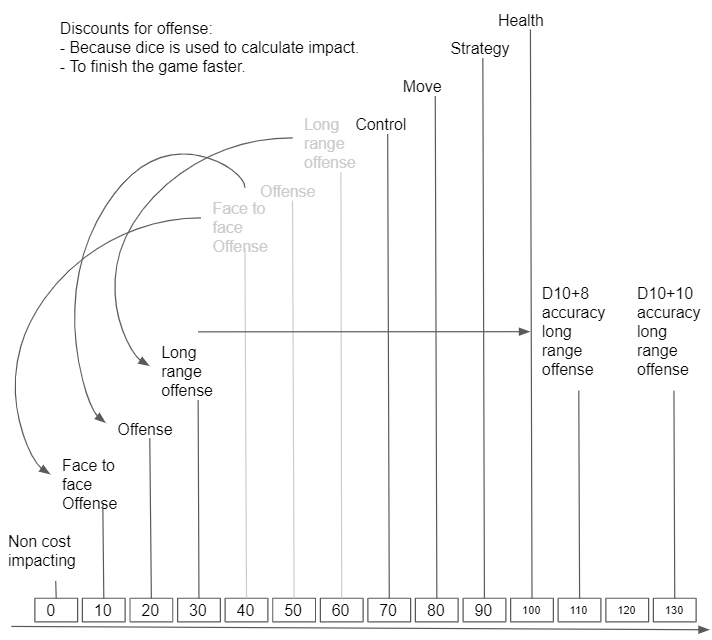
8.2.2- Allowed themes, races, and objectives
Objective can be capture-a -flag (object, or cargo) and keep it for some number of turns. It could be control-a critical-position and hold it for a number of turns. It could be a race, complete enemy annihilation or whatever players agree to. Theme or universe could be ancient, historical, modern, futuristic or mixed. Vendors could be anything, scale could be anything. Whatever range players are comfortable in is a go. Races can be anything and can be found in the skill database as each will have different health points, but the common ones are: undead, elves, orcs, trolls, goblins, dwarfs, humans, hobbits, smurfs or any comic creatures, aliens of all types, cyborgs, augmented humans, clones, robots (different types), animals, zombies, werewolves, vampires, wizards, cyclops, minotaurs, centaurs, Satyrs, Fauns, pegasus, Any anthropomorphic animals, deities, and demigods. Here is a fun matrix of different archetypes.
8.2.3- Maximum ammunition and energy of 20
Unless the players have reasons to do otherwise, we can consider the maximum number # of ammunition, fuel, and energy to be 20. 20 is also the default value. This helps make the game faster since you’d only need to keep track of skills that does not have #=20, like a couple of grenades for example. A game will probably finish before any of the units communicates, moves, or attacks 20 times with the same weapon. However, in case the game does not finish in this range, it is safe to assume that units can collect ammunition and other resources from other dead units that never got to finish all their resources.
8.2.4- Figure Quality
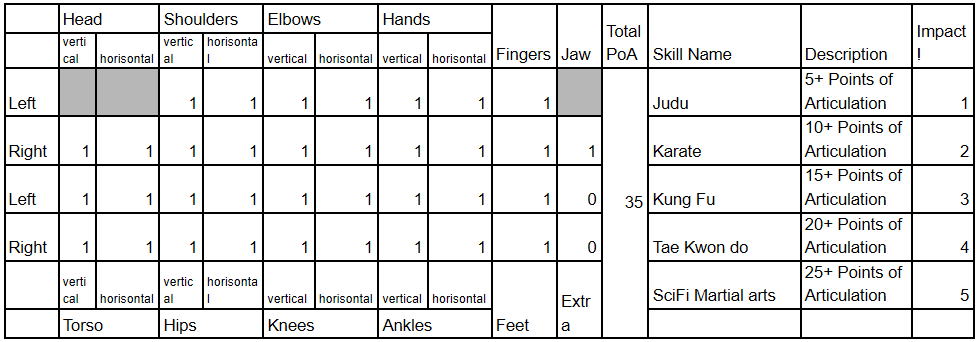
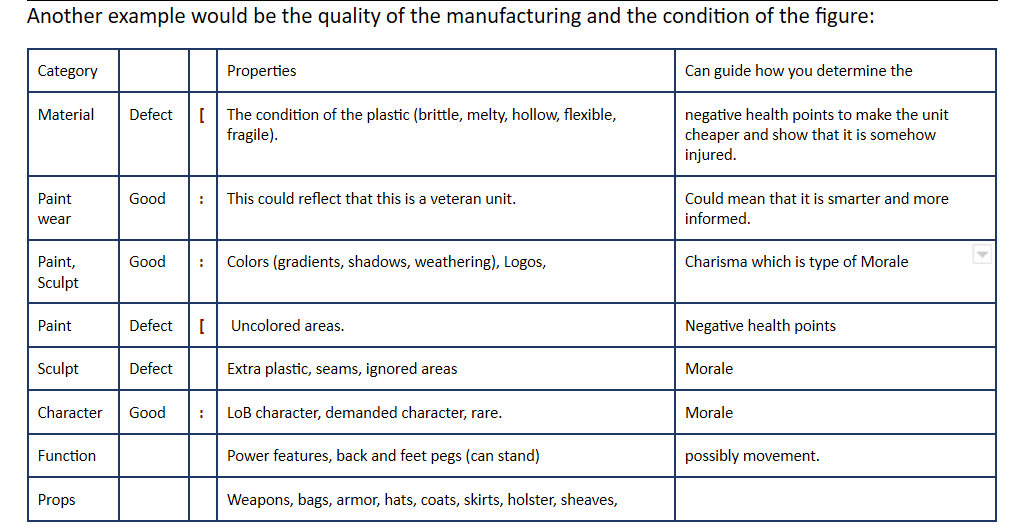
You can use the figure quality to decide some of its skills but that should not prevent you from assigning whatever skills needed to any figure if needed. For example, The points of articulation of a figure can help decide its hand to hand offense abilities.
8.2.5- Skills’ properties
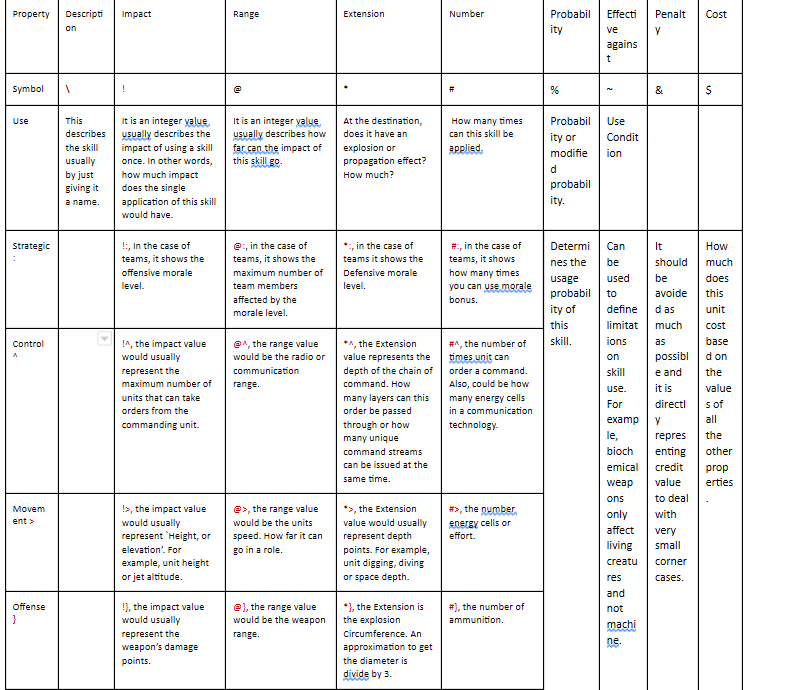

8.2.6- Defaults’ table
8.3- Recap on types of bonuses
Move and command bonuses are related using farsight rule (maps, compass, magic, binocular, advanced troops that can report back using comm).
8.3.1- Offense weaknesses and defense bonuses
Offense gets to be used less than 50%, and much less for melee weapons. Offense gets 55% of the impact on average because we use an impact dice that gives 10 to 100 percent. Offense gets spent in batches that overflow (using a weapon with 10 impact to kill a unit that has 3 health points left in # will waste the rest of the impact). Offense gets one dice point ducted if the other unit is hiding and another if the unit is higher up.
8.3.2- Offense bonuses and defense weaknesses
Offense is much cheaper. Offense can use extra dice on the field. If a unit gets resurrected it gets to use the same weapons. Offense gets an extra dice point if the defender was retreating/taking cover. Offense can get extra d10 x4, x9, x16, x25, or x36 for pincering or flanking the defenders. That depends on how many sides the enemy is outflanked at. Theoretically, in space, or 3D any space, there are 6 sides. Team morale offense and defense speeches apply to the attack only. (This rule is not active because it complicates things.) Some units can pick up weapons and ammunition. Sniper and high accuracy attack bonus. Always round up and always go for the kill general rule of thumb. The difference in maneuvering leverage (height, elevation, depth, etc) between the attacking and attacked unit is added to the impact before the D10 is rolled.
8.3.3- Field bonuses
Players can find extra dice, inactive neutral units, treasure chests, medic packs, ammunition packs, and weapons on the field that they can take over and use.
8.4- Bonuses defaults table
